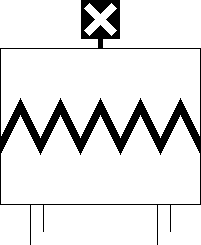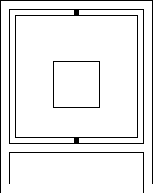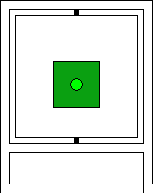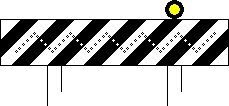|
|
|
|
|
|
This section provides descriptions of various signs and indicators that are for miscellaneous purposes not covered by the other sections of the website.
In the days of steam haulage, water columns were installed at strategic locations such as important stations, where locomotives could stop to replenish their water. The Southern Railway provided a sign with a letter "W" for "water" [25.1 & 25.2] to indicate the position where locomotives should stop to take on water.
 |
 |
|
[25.1] Water Stop Sign.
Area: Southern Railway Usage: Unknown Status: Historical |
[25.2] Water Stop Sign.
Area: Southern Railway Usage: Unknown Status: Historical |
|---|
In some locations, water troughs were laid in the 'four-foot' to enable steam locomotives to collect water while on the move. The first troughs were installed by the London & North Western Railway at Mochdre, North Wales, and these were brought into use in October 1860. Installations of water troughs spread throughout the country's mainlines, apart from on the Southern Railway. A distinctive marker was erected at the lineside to give warning of the approach to a trough. This comprised a large white rectangular board with a black zigzag across it, fixed on the skew and surmounted by a small illuminated indicator showing a white diagonal cross [25.3]. A similar indicator mounted on its own [25.4] was positioned at the start of the trough, where the fireman should lower the scoop.
 |
 |
|
[25.3] Water Trough Warning Board.
Area: All Areas except Southern Railway Usage: Medium Status: Historical |
[25.4] Water Trough Commencement Indicator.
Area: All Areas except Southern Railway Usage: Medium Status: Historical |
|---|
In April 1966, new marker lights were installed at the water troughs at Wiske Moor (North Eastern Region), near Northallerton, replacing the previous signs. The 'lower scoop' markers, positioned 50 yards (46 metres) on the approaches to the troughs, each comprised a yellow post carrying two white lights, one of which was focused across the line [25.5]. The 'raise scoop' marker posts, which were located 440 yards (402 metres) before the ends of the troughs, were also coloured yellow but carried a single blue light [25.6].
 |
 |
|
[25.5] 'Lower Scoop' Marker.
Area: Wiske Moor Usage: Low Status: Historical |
[25.6] 'Raise Scoop' Marker.
Area: Wiske Moor Usage: Low Status: Historical |
|---|
|
When a train was to be admitted into a permissive goods loop and the line was occupied by other trains, the regulations required that it be stopped at the signal box so that the signalman could verbally advise the driver as to how many trains were already in the loop. To obviate this requirement, A T Blackall of the Great Western Railway designed the 'goods loop indicator', to be fitted to the post of the signal for entering the loop. These were in use at a few locations from c.1905. The indicator was capable of displaying a figure from "0" to "5" to show how many trains were in the section ahead [25.7]. During fog or falling snow, or where the gradient was falling at steeper than 1 in 100, it was necessary for the signalman to verbally advise the driver, irrespective of whether or not an indicator was provided, even if the loop was empty. The goods loop indicators were abolished in 1941. |
|
At some locations, an electrical fouling bar was installed on the track to operate an indicator inside the signal box. Care had to be taken to ensure that light engines or vehicles stood over the fouling bar so that the signalman would be aware that the line concerned was occupied. On the London, Brighton & South Coast Railway, circular or elliptical signs showing the letters "EFB" above a star symbol [25.8] were provided to indicate the position of a fouling bar. Alternatively, double-sided lamps showing a blue star and a blue arrow on each side were provided [25.9]. These indicator lamps were still being installed in Southern Railway days.
 |
 |
|
[25.8] Fouling Bar Sign.
Area: LB&SCR Usage: Medium Status: Historical |
[25.9] Fouling Bar Indicator.
Area: LB&SCR Usage: Medium Status: Historical |
|---|
|
A track circuit may be installed on the approach to a stop signal to automatically indicate the presence of a train to the signalman. When a train was brought to a stand at the signal, the driver had to ensure that the train was occupying the track circuit. As an aid to drivers, the North Eastern Railway marked each limit of a track circuit with a small plate at the side of the line, facing the track. This had the words "track circuit" above an arrow, which pointed in the direction of the track circuit [25.10]. |
|
From 1926, the Southern Railway provided 'intermediate platform signals' on certain platform lines at terminal stations when resignalling with colour light signals took place. A single yellow aspect (see [2.106]) on the intermediate platform signal meant that the platform starting signal was displaying either a single yellow or a double yellow aspect. A green aspect (see [2.107]) on the intermediate platform signal meant that the platform starting signal was displaying either a green aspect, or a red aspect with a miniature green in the associated shunting signal (see [4.62]). To differentiate between the two, an indicator provided on the intermediate platform signal showed "M" [25.11] if the platform starting signal was exhibiting a main 'proceed' aspect, or "S" [25.12] if the shunting signal was cleared.
 |
 |
|
[25.11] "M" Indication.
Area: Southern Railway Usage: Medium Status: Historical |
[25.12] "S" Indication.
Area: Southern Railway Usage: Medium Status: Historical |
|---|
In 1934, following discussions with the Ministry of Transport, the LNER developed proposals for a simplified signalling system comprising fixed and movable boards with a view to reducing maintenance costs on rural branch lines. It had been intended to install the new system on at least three branch lines: Reedness to Haxey Junction, Northallerton to Hawes, and Knaresborough Goods to Pilmoor North. In the event, only the Knaresborough - Pilmoor line was converted. Although the new boards were installed in 1935, they were not brought into use until February 1936, when all the conventional signals along the route (excluding its extremities) were removed.
At each intermediate station where there had previously been a signal box, a 'station board' was installed. In the 'on' position, the face of the board appeared white all over [25.13]. To admit a train into the station, a trap door was opened to reveal a green square and a green light as the 'proceed' indication [25.14]. The whole board was capable of being rotated through 180°, so that the same board could be used to signal all trains at that station regardless of their direction of travel.
 |
 |
|
[25.13] Station Board ('on').
Area: Knaresborough - Pilmoor Usage: Low Status: Historical |
[25.14] Station Board ('off').
Area: Knaresborough - Pilmoor Usage: Low Status: Historical |
|---|
On each approach to a station, a 'section limit board' was installed. This had red and white diagonal stripes and was studded with three clusters of red reflectors down the middle and white reflectors around the edges [25.15]. Trains were required to stop at the section limit board unless the green square or green light was visible in the station board ahead (see [25.14]). A 'location marker board' was erected at braking distance on the approach to the section limit board. As originally installed, these boards had black and yellow diagonal stripes and white reflectors arranged in a zigzag pattern [25.16], but to improve their long-range visibility against a background of foliage, the stripes were altered to black and white [25.17] before being brought into use. Distinctive boards were also introduced at the level crossings on the line (see [16.11 - 16.13]).
 |
 |
 |
|
[25.15] Section Limit Board.
Area: Knaresborough - Pilmoor Usage: Low Status: Historical |
[25.16] Location Marker Board.
Area: Knaresborough - Pilmoor Usage: Low Status: Historical |
[25.17] Location Marker Board.
Area: Knaresborough - Pilmoor Usage: Low Status: Historical |
|---|
After passenger services on the line ceased in September 1950, all the station boards (see [25.13 & 25.14]) and section limit boards (see [25.15]) were removed, while the location marker boards (see [25.17]) were retained. Each location marker board was subsequently fitted with a yellow marker light [25.18]. The line closed to all traffic in October 1964.
 |
|
[25.18] Location Marker Board.
Area: Knaresborough - Pilmoor Usage: Low Status: Historical |
|---|
|
|